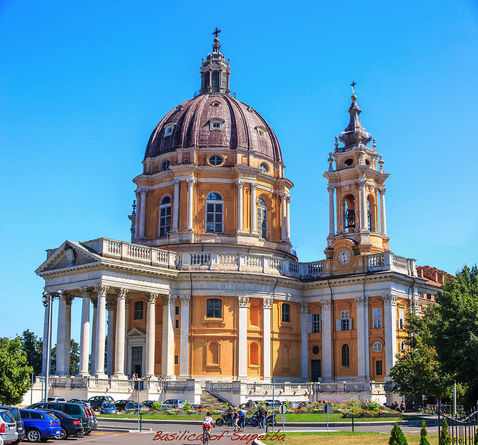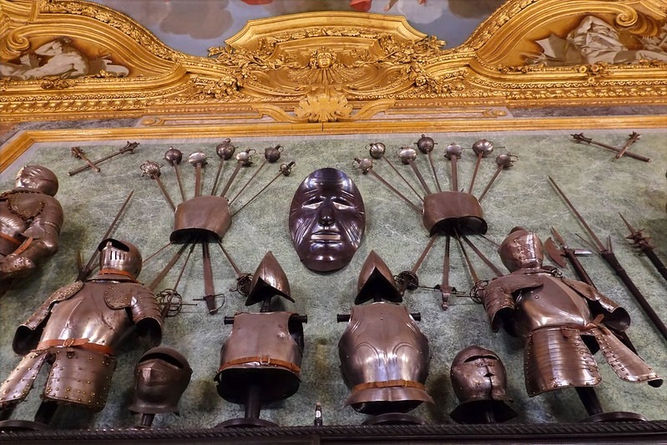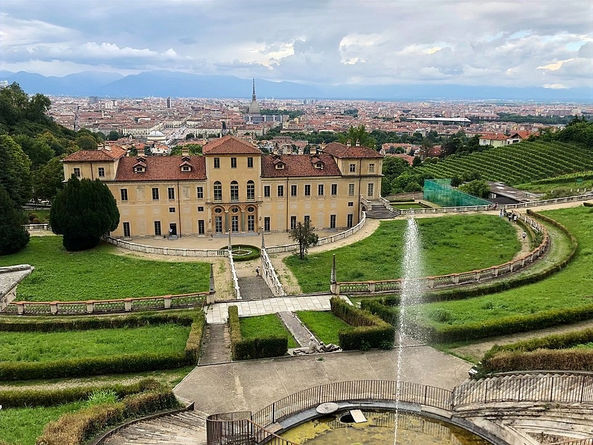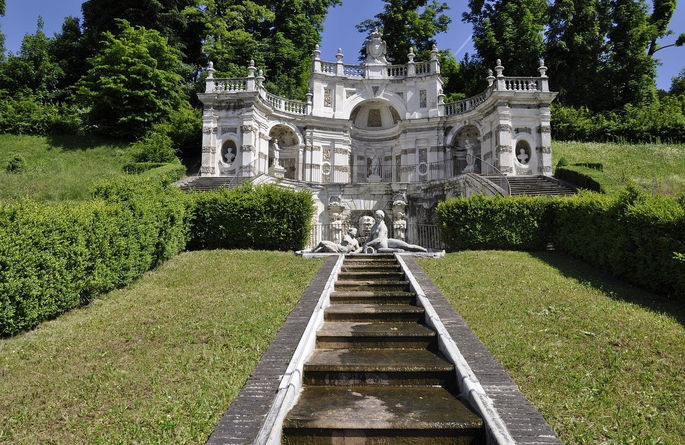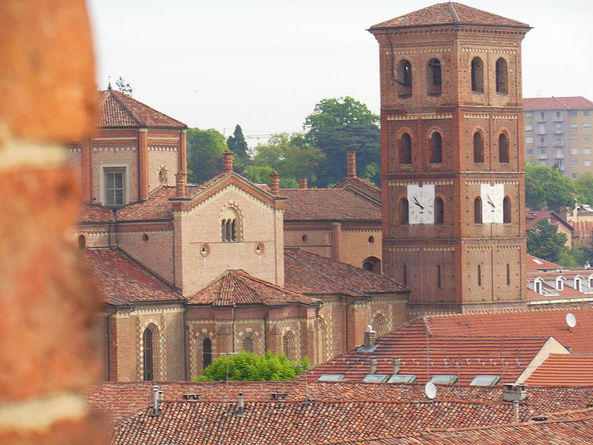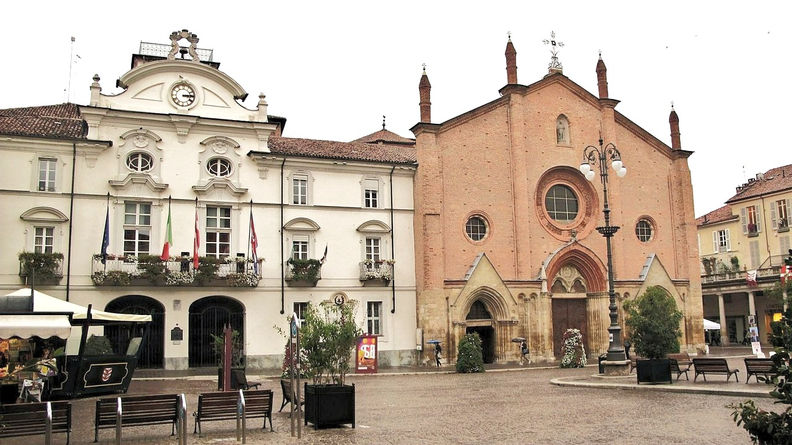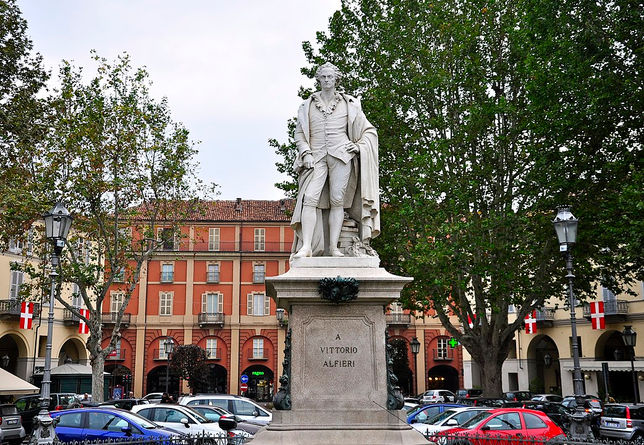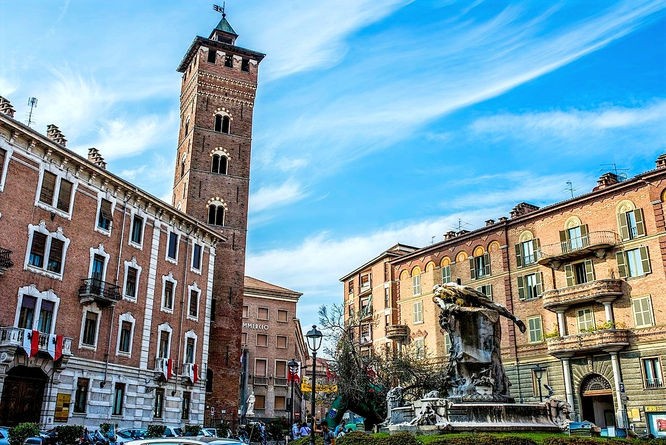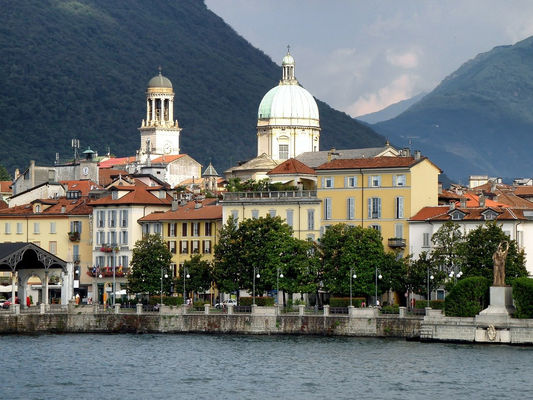
Piedmont

Piedmont is in Italy's northwest and borders Switzerland and France.
It is surrounded on three sides by the Alps, with the highest peaks and largest glaciers in Italy. Some of the popular cities in the region are Alba, Alessandria, Asti, Cuneo, Ivrea, Lake Maggiore, Langhe, Monferrato, Novara, Serravalle Scrivia, Stresa, Verbania, Vercelli and Turin, the capital of the region.
Piedmont is celebrated for its fabulous wines, Autumn truffles, and beef. Piedmontese cattle are so famous that they're reared all over the world. The region has the biggest hazelnuts plantation. The Italian Gianduj chocolate, combination of chocolate with the region’s native hazelnuts, was created in Turin in 1865. The famous Chocolate company Ferrero, second biggest chocolate producer in the world, was founded in 1946 in the city of Alba.
Besides foodie paradise, it has many beautiful mountains with plenty of ski resorts and many lakes nestled between its mountains and valleys. The most famous of which is Lake Maggiore.
There are five UNESCO Heritage Sites in Piedmont.
-
Ivrea, industrial city of the 20th century
-
Prehistoric Pile Dwellings around the Alps (Shared with Lombardy, Trentino-Alto Adige)
-
Residences of the Royal House of Savoy
-
Vineyard Landscape of Piedmont: Langhe-Roero and Monferrato
-
Sacri Monti of Piemonte and Lombardy (7 in Piemonte and 2 in Lombardy)
By Nicolae Baltatescu - Pixabay
Turin
Turin, is erected around the riverside of Po, in the picturesque hills of Monferrato. In 1861 Turin was made the first capital of a unified Italy, in 1865 the capital was moved to Florence and then finally in 1870 to Roma, which has remained the capital. It is now the capital of the Piedmont region.
Turin has a lot to offer, it is home to a number of Castles and Royal Palaces with remarkable historical and artistic value, for example the elegant Residences of the Royal House of Savoy, lisited as UNESCO World Heritage Sites, with scenic architectural heritage of past times, the renaissance, baroque, rococo, neo-classical and art-nouveau palaces. Turin has many shady parks, art galleries, museums and streets filled with piazze and café. Most famous Italian car factories like Fiat, Alfa Romeo and Lancia are based here as well.
The beautiful tree-lined grand boulevards filled with many cafes, and boutiques of designer labels such as Louis Vuitton, Gucci, and Hermes, can be found here. The marble arched porticoes along the arcades were built to allow the nobility to stroll without getting wet in winter and away from the sun during summer.. It has conquered the supremacy of the city with the widest pedestrian area in Europe.
A mixture of historic and modern set against the backdrop of the Alps will make your draw drop.
Cathedral of St. John the Baptist and the Chapel of the Holy Shroud
The Cathedral was built during 15th century, on the site of three early Christian Basilica and the Chapel of the Holy Shroud was added to the structure in 1668–1694. The Chapel is connected to the Royal Palace of Turin, where the Shroud was kept for more than 400 years.
In 1997, the Chapel was severely damaged by a massive fire, but the Shroud was saved. Subsequently, it was closed to the public and took over 21 years, and €30 million to restore to its original splendour. On September 27, 2018, the chapel reopened to the public.
The Shroud of Turin
Shroud of Turin, is a mysterious linen cloth that many believe once wrapped the body of the Jesus at the time of his burial. It bears the image of a man who believe by many to be Jesus, appears to have suffered physical trauma in a manner consistent with crucifixion. Despite the fact that 600 years ago, Pope Clement VII declared the shroud was a fake, it remains an important religious symbol for Christians around the world.
There has been no end to the debate about the shroud’s authenticity. However, in 2018, new forensic research suggests the blood stains on the shroud couldn’t have come from Christ.
The Shroud is not open to public. The last publicly displayed was in 2015 and next public viewing to be 2025, which was declared by Pope John Paul II.
However, in April 2020/21 Easter, the Shroud went on virtual display, with Turin Archbishop Cesare Nosiglia praying before the Shroud, and invited the faithful worldwide to join from home, to pray for an end to the coronavirus pandemic.
Egyptian Museum
In Turin, you can visit one of the largest collection of Ancient Egyptian artifacts outside Egypt. the museum has a number of exhibitions focussed on the ancient kingdom, including the Assemblea dei Rei, made up of statues of the New Kingdom kings, tombs of Kha and Merit, and the Papyrus Room.
Mole Antonelliana
Another outstanding building is Mole Antonelliana, the symbol of Turin, which was meant to be the Turin’s synagogue, now housed the National Cinema Museum, the place to learn more about the history of film. You can take the elevator the top and enjoy a birds eye view of the city.
Basilica of Superga
The Basilica of Superga, an imposing baroque style basilica, raised on a hill, with exceptional far reaching views across the city of Turin, is worth a visit.
Residences of the Royal House of Savoy UNESCO World Heritage Sites
The elegant Residences of the Royal House of Savoy compose of 22 buildings built between the 17th and 18th century by the Dukes of Savoy. These structures are of great historical, unique architectural, artistic and environmental value. The complex was recognized by UNESCO in 1997. Come and discover the Court of Italy from Torino to Cuneo, through the Langhe Roero and Monferrato territory! Experience stunning settings and an extraordinary cultural heritage, unforgettable moments to live with your family or among friends for a day like a King!
The most important building is undoubtely the Royal Palace (Palazzo Reale), which was the official residence of the Savoys. Today this lavish Palace houses the homonymous museum, where numerous, centuries-old objects and furnishings belonging to the sovereigns are held. The impressive Royal Armory and its collection of stuffed horses with their armored riders and other items dating from the 15th to 19th centuries, is one of the largest collections in Europe. Beyond the Palazzo Reale are the beautiful Royal Gardens (Giardini Reali) and the Museo d'Antichità, filled with archaeological finds dating from prehistoric times through the late Roman era.
In the center of Turin the Palazzo Madama, site of the Civic Museum of Ancient Art. Next, the Palazzo Carignano, now housing the National Museum of the Risorgimento and the Castello del Valentino, home to the Architecture Faculty of the Polytechnic University of Turin, is located in the largest park in Turin, Parco Valentino, a romantic park with shaded walkways, on the banks of the Po River. It’s a great place to unwind on a laid-back afternoon! Another charming villa not to be miss is the Villa of the Queen (Villa della Regina), a 17th century palace immersed in the greenery of Turin’s hillside, surrounded by a large wine vineyard and orchards. It was the former summer residence of the Royal ladies and the Savoy family. Villa della Regina hosts Turin’s very own urban vineyard, producing an excellent red wine, Freisa di Chieri DOC.
Around the area of the Province of Turin are Borgo Castello (within La Mandria Park), the splendid and extremely charming architectural structure of Royal Palace of Venaria, the Royal Castles of Moncalieri, Rivoli and Aglié, and the Hunting Lodge of Stupinigi.
In the Province of Cuneo, are the Royal Castle of Racconigi, a grand construction done in multiple styles, the Castles of Pollenzo and Govone, rich in wooden furnishings and decorations, and the Residence of Valcasotto.
A particularity of the Savoy Residences is their extravagant gardens and parks with organized elegant landscape that strike the visitor's eye !
Ivera
The picturesque town of Ivrea near Turin although it is not a major tourist destination, but it is an industrial city of the 20th century, protected by UNESCO World Heritage Site for its collection of modern architecture. All because of Camillo Olivetti, an entrepreneur and manufacturer for typewriter, mechanical calculators and office computers. There are several interesting sights, most notably is the Olivetti Building, Castello di Ivera, Bishop's Palace and the Cathedral.
Olivetti Building
Take a stroll and admiration around the axis of the Via Jervis, across 72,000 hectares of buildings designed by the most famous architects and town planners in Italy. The buildings were needed for manufacturing, social services and housing for the workers, directors and designers of the Olivetti industry.
Castello
In Piazza Castello, stands the Ivrea castle.The castle was built in 14th century, and it has a solid structure, characterized by the high circular towers. Once a prison, the castle today houses exhibitions.
Cathedral
Ivrea Cathedral, with three naves, despite many restorations that have been carried out over the centuries – it preserves several features dating back to the medieval period. These include the semicircular apse and two bell towers of Romanesque style, some columns, and the frescoed crypt still remain.
Alba
The town of Alba, in the province of Cuneo, not only known for its white truffles, it is also a very important center for wine production.
The International Fair of the WhiteTruffle of Alba celebrates their famous 'tartufo bianco' over a two month period from The first week of October , lasting until the final week of November, is one of the most famous event in Alba.
The wines of Alba are among the most renowned in Italy and are divided into:
• DOC: Barbera, Dolcetto, Nebbiolo.
• DOCG: Barbaresco, Barolo, Moscato.
The vineyards over the undulating hills are beautiful at any season, but visiting them in the fall when the leaves change its colour is especially photogenic. Remember to savor the Barbera and Barolo Wines at their origin, pairing it with the local specialties!
Aside from being a foodie heaven, Alba is the quintessential fortified medieval town with a soaring 12th-century gothic cathedral, Cathedrale di San Lorenzo, with a bell tower for city views. The Federico Eusebio Museum houses artifacts from prehistoric to Roman times, plus a natural history section. On Saturdays, the whole town is occupied by a classic Italian street market selling fresh produce, clothing and jewelry.
Alessandria
The city of Alessandria, capital of the province, lies between the Bormida and Tanaro Rivers and located right in the middle of the industrial triangle in between Milan (97 km), Turin (90km) and Genoa (86km). If you’re visiting these three cities, don’t miss out on a visit to this delightful city, you will be surprised by some of the unique things that this city has to offer. Alessandria is renowned for its manufacture of high quality hats, in particular the Borsalino brand and has left a deep legacy in the city.
Citadel
The Citadel is undoubtedly the most impressive complex in Alessandria, a magnificent fort that has stood since the 18th century. It served as a defensive garrison to the city during the reign of Savoy . You may take a leisure walk around the grounds of the citadel to admire the architecture.
Ponte Meier
Ponte Meier spanning over River Tanaro, connecting the city centre to the Citadel of Alessandria, is an iconic structure in Alessandria. This bridge was constructed in the 1990’s by renowned architect Richard Meier and features a dual design with a public road and a separate pedestrian walkway. The architecture and design are truly stunning! You may consider using this bridge to cross over to the Cittadella.
Piazza Garibaldi
One of the popular squares in the centre of Alessandria, Piazza Garibaldi features some fine architecture and also holds large markets. On all sides the square is surrounded by arched porticos with a selection of fantastic shops and cafes.
Cathedral of Alessandria
The cathedral of Alessandria has the second tallest tower in Italy. Opposite the church there is the Conservatory of Alessandria.
Palazzo Ghilini
Palazzo Ghilini, one of the best examples of 18th Century architecture in Italy and most important building in the city centre. A royal residence of the Ghilini family, whose history is intertwined with that of Alessandria. Although you cannot enter the palace, you can admire the architecture from the exterior . The front façade features a series of stone columns, windows with decorative pediments and a grand entrance.
Arch of Trionfo
Whilst walking through the town, visit the fantastic Arch of Trionfo, one of Alessandria’s most important monuments, constructed in the 18th century.
Galleria Guerci
The Galleria Guerci has a similar design to the well-known gallery in Milan and is a great place for shopping or to relax to sip an espresso! Corso Roma is the main shopping street, with many boutiques and a range of high end fashion brands.
Borsalino Hats Museum
Giuseppe Borsalino founded the factory in Alessandria in 1857 and soon its stylish fedoras and panama hats became an icon of ‘Made in Italy’ craftsmanship.
The Museo Cappello Borsalino provides insight into the history of the premier hat making factory and contains a wonderful display of over 2000 different pieces of headgear.
Asti
The province of Asti, is mostly hilly territory stretches across Monferrato and is traversed by the Tanaro River.
Gentle hills and valleys, created scenery of unique beauty, with vineyards stretch as far as the eye can see. Asti is best known for producing Asti Spumante and Moscato d’Asti, two celebrated sparkling white wines made from the Moscato Bianco grape, exported all around the world. You can savor them at any of the town’s many charming wine bars or venture to a nearby winery for a formal tasting.
Cathedrale of Santa Maria Assunta
The City of Asti is capital of the province. In the historical town, see the art work in Asti’s Gothic cathedral, the beautiful and impressive Cathedrale of Santa Maria Assunta, also known as the Duomo, has been built and rebuilt several times for over 700 years.
Piazza San Secondo
A lovely town square overlooking the Palazzo Civico (town hall)
Piazza Alfieri
Take a stroll through the lively, Piazza Alfieri, named after Italy's most renowned 18th-century poets, Vittorio Alfieri. It is lined by porticoed buildings and contains the marble and granite Vittorio Alfieri.
Like Siena in Tuscany, Asti also hosts one of Italy’s oldest Palio competitions (medieval horse races) in Piazza Alfieri, on the first Sunday in September since 1275, making it one of the oldest races of its kind in Italy!
Troyana Tower
During the late 13th century, Asti became one of Italy's wealthiest city, with 150 towers springing up, thus, Asti was known as "the city of 100 towers". Of the 15 that remain today, only Troyana Tower, 38m-tall tower is open to public. A climb to the top promises magnificent views of the city and its surrounding countryside. The clock was added in 1420.
Biella
The province of Biella is a green area surrounded by the Alps.
The city of Biella, capital of the province, is spread over several levels, The oldest part Piazza Duomo is where the Romanesque Baptistery rises; the Renaissance complex of San Sebastiano, whose cloister is now home to the Museo del Territorio Biellese. The medieval village of Piazzo, located in the upper part of Biella, can be reached using the historic funicular that offers a picturesque panorama of the city. Biella is an important wool processing and textile centre. Biella produce fine yarns and fabrics of excellence quality. It is the headquators of famous Cerruti 1881 (men,s wear), Ermenegildo Zegna (men'swear) and Fila (sportswear). Thanks to textile factories, a dense network of corporate outlets has emerged for quality shopping that attracts customers from all over the world.
Canelli
Canelli a city in the province of Asti, located in the Monferrato Altro, is rich in vineyards. The area is believed to be the birthplace of the Italian sparking wine. The village's history of the wine is still evident today with the popular Muscat Canelli that is still used for the Moscato grape used to produce the wine.
The area is declared as UNESCO World Heritage Sites, under the Vineyard Landscape of Piedmont: Langhe, Roero (Province of Cuneo) and Monferrato (Province of Asti)
Cuneo
The city of Cuneo , the capital of the province of Cuneo, is interesting to explore, with wide streets partly in renaissance style that are pleasant to amble along and a small historical old-town which is the remains of the 12th century fortified town around which Cuneo developed, which is interesting to explore. Piazza Galimberti, the large central square in Cuneo which is surrounded by arcades and historical buildings. Via Roma is among the most popular streets in the town , lined with notable monuments including the Palace Casa Galimberti, the Town Hall, the Bishop's Palace and Palace of the prefecture. Other religious monuments include the baroque style cathedral, the Church of Santa Maria della Pieve and the neo-classical reconstruction of the Chapel of Santa Maria del Bosco.

Piazza Galimberti, Cuneo
By Alessandro Vecchi-wikimedia.org, CC By SA- 3.0
Domodossola
Domodossola, in the province Verbano Cusio Ossola, retaining an evocative Medieval appearance with the backdrop of Monte Rosa, the Anzasca Valley opens up right where the resort of Macugnaga and the ancient gold mine of Guja are located. The Walser Museum-House provides historical and cultural information about the ancient Walser people.

City Hall, Domodossola
By vco24-Pixabay

Market Square
By LittleJoe-wikimedia.org, CC By SA-3.0
By Alessandro Vecchi -wikimedia.org, CC By SA-3.0
Macugnaga
Macugnaga, a fairy-tale mountain village in the valley of Monte Rosa over the border from Zermatt in Switzerland is one of the most picturesque and least touristy bases for skiing and hiking in the Piedmont Alps. It is a true rural idyll where you’ll find cows grazing on the pastures surrounding one of the local churches.

Monviso
Monviso, in province of Cuneo, the Piedmont side of Monte Rosa and the other spectacular mountains in the region, create incredibly beautiful landscapes, and ski resorts around Via Lattea di Sestriere, one of the most important winter sports complexes in Europe.

Sestriere Ski Resort
By Leo-setä-flickr

Monviso
By nonmisvegliate- Pixabay
Neive
Located just northeast of Alba, the town of Neive has some of the same gastronomic delights but with less fanfare and fewer tourists. If you walk along Neive’s cobbled streets of rusty-hued cottages, you’ll catch glimpses of the surrounding verdant hills. It is another typical Langhe village with a mixture of buildings from the 13th to the 18th century around the squares, filled with lively village life.
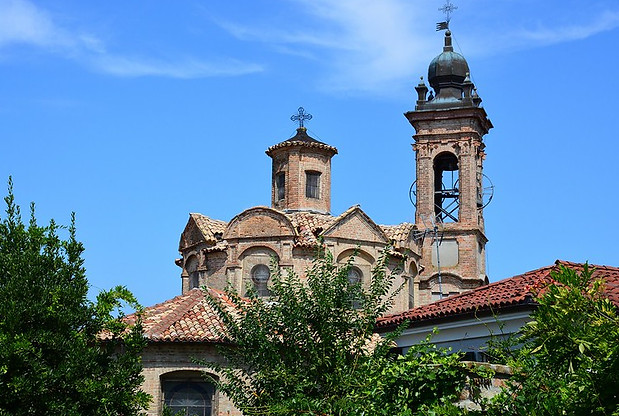
By Paul Arps-flickr
Novara
The province of Novara, an important crossroads for commercial traffic along the routes from Milan to Turin and from Genoa to Switzerland. Like Vercelli, it is also a leading rice producers .
The city of Novara, capital of the province, can be divided into two groupings. The city's most important sights lie within its historic centre, the area once enclosed by the city walls. However, several important sights also lie outside the line of the former city walls. The most imposing monument in the city is the Basilica of San Gaudenzio, with a cupola 121 metres high, constructed in 1888. The bell tower is also of particular interest.
Serravalle Scrivia
Serravalle Scrivia is a city in the Province of Alessandria, and has the biggest Facctory Outlet in Italy!

By Go Travelling, Public Domain
Val d’Ossola
Val d’Ossola is carved by the Toce River, whose source lies in Val Formazza and, overlooking a plunge of over 400 meters, to the most beautiful and powerful waterfall in the Alps. The Cascata del Toce is a stunning and mesmerising waterfall, a must-see attraction for anyone visiting the area.

Cascata del Toce
By Antontn-wikimedia.org
The Lake District in Verbano-Cusio-Ossola
The Province of Verbano Cusio Ossola lies in the northeastern strip of Piedmont, on the borders of Switzerland and Lombardy. This region awaits visitors to its many natural treasures; idyllic, peaceful mountain scenery, breathtaking panoramas, verdant pastures, unspoilt lakes and extensive system of valleys. Every valley offers exploratory excursions to discover the architecture and cultural. Among the pearls that make this environment unique are the little Lake Mergozzo, Lake Orta, and the western bank of Lake Maggiore , the most sought-after tourist resort, that hosts renowned resorts like Cannobio, Cannero Rivier, Baveno, Stresa and Verbania, capital city of the province.
Lake Orta
Picturesque views are also a feature of Lake Orta, a tranquil and serene small lake, surrounded by woods and hills, with a picturesque setting of Island of San Giulio sitting in the middle of it. The northern bank lies the historic village of Omegna, where the coffee maker and the pressure cooker were invented in the last century, is also a town worth seeing.
Stresa
Stresa, full of important architectural examples, in particular the marvelous Villa Ducale, surrounded by beautiful lawns and gardens, with an enchanting view of the Borromean Islands, especially Isola Bella, dominated by the majestic Palazzo Borromeo.
Verbania
Verbania, the capital of the province Verbano Cusio Ossola, is an ideal, relaxed setting on the shores of Lake Maggiore. This lovely lakeside city is known as “the garden on the lake” boasting the renowned 19th century mansions like Villa Taranto, whose botanic gardens are among the best known and most visited in Europe, Villa San Remigio and Villa Giulia .
Vercelli
The Province of Vercelli lies in northeastern Piedmont, extending along the Sesia River from Monte Rosa to the Po River, through the Baragge and flatlands. A spectacular panorama of rice paddies characterize Vercelli, one of Europe’s leading rice producers: rows of poplar trees divide the plain symmetrically, submerged for most of the year and reflecting the sky's many colors and hues.
Vercelli city, the capital of the province, is dominated by the imposing Romanesque-gothic Basilica di Sant'Andrea, and by the Duomo with its high Medieval bell tower.
Among the various attractions that should not be passed over is the Borgogna Museum, a collection of the most important artworks in Piedmont; its paintings date from the Renaissance to the 1800s.
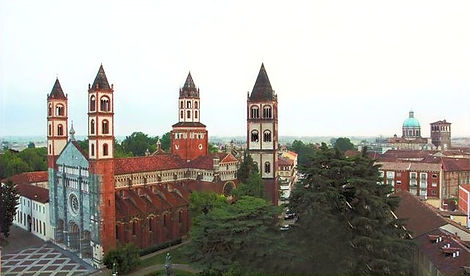
Basilica di Sant' Andrea
By Blusea2001 -wikimedia.org

Duoma
By Blusea2001 -wikimedia.org
Vineyard Landscape of Piedmont: Langhe, Roero and Monferrato
UNESCO World Hertage Site
Vineyard Landscape of Piedmont: Langhe, Roero (Province of Cuneo) and Monferrato (Province of Asti)
The hilly landscapes of the Langhe, Roero and Monferrato, with villages and castles pearching on a succession of gentle slopes, planted with rows of vine. This breathtakingly dramatic landscapes of Piemont wine growing area is celebrated for producing world-renowned wines from ancient grape varieties. It has been recognised as UNESCO World Heritage Site in 2014.
Sacred Mountains (Scari Monti of Piedmont and Lombardy)
UNESCO World Hertage Site
The Sacri Monti of Piedmont and Lombardy are groups of chapels and other architectural created in the late 16th and 17th centuries, as places of pilgrimage. There is a total of nine holy mountains known as the Sacred Mountains or Sacri Monti scattered around Lombardy and Piedmont. In Lombardy, there are two Sacred Mountains, one in Varese and the other in Ossuccio, while the remaining seven are on the Piedmontese territory. The Scared Mountains have been included in the Unesco World Heritage Site list since 2003.
The nine Sacri Monti included in the World Heritage Sites are:
-
The Sacro Monte of Nuova Gerusalemme (New Jerusalem) of Varallo Sesia (1486), Varallo Sesia, province of Vercelli (Piemont)
-
The Sacro Monte of Santa Maria Assunta, Serralunga di Crea (1589), province of Alessandria (Piemont)
-
The Sacro Monte of San Francesco, Orta San Giulio (1590), province of Novara (Piemont)
-
The Sacro Monte of the Blessed Virgin, Oropa (1617), province of Biella (Piemont)
-
The Sacro Monte of the Holy Trinity, Ghiffa (1591), province of Verbano-Cusio-Ossola (Piemont)
-
The Sacro Monte and Calvary, Domodossola (1657), province of Verbano-Cusio-Ossola (Piemont)
-
The Sacro Monte of Belmonte, Valperga (1712), Metropolitan City of Turin (Piemont)
-
The Sacro Monte of the Rosary, Varese (1598) (Lombardy)
-
The Sacro Monte of the Blessed Virgin of Succour, Ossuccio (1635), province of Como (Lombardy)
The Sacro Monte of New Jerusalem of Varallo Sesia
Sacro Monte di Varallo overlooking the town of Varallo Sesia in the province of Vercelli. It is the oldest
Sacro Monte, founded in 1491 by Franciscan prist Bernardino Caimi. It was built on a natural terrace on the rocky slopes of Monte Tre Croci ("three crosses mountain"), on the left bank of the Sesia river where it leaves Val Mastallone. It is 600 m above sea level. It comprises the basilica and 45 chapels. It is listed as UNESCO World Heritage Site under the nine Sacri Monti (Sacred Mountains) places of worship.
The Sacro Monte di Crea
The Sacro Monte di Crea is a Roman Catholic sanctuary in the comune of Serralunga di Crea, in province of Alessandria. It is reached via a steeply ascending route which winds through a wooded natural park. It is listed as UNESCO World Heritage Site under the nine Sacri Monti (Sacred Mountains) places of worship.
Sacro Monte di Orta
The Sacro Monte di Orta is a Roman Catholic devotional complex in the comune of Orta San Giulio , in the province of Novara on the summit of a hill known as San Nicolao, which faces the western shore of Lake Orta. It is one of the Sacri Monti of Piedmont and Lombardy, included in UNESCO World Heritage list.
Sacro Monte di Oropa
The Sacro Monte di Oropa is a Roman Catholic devotional complex in the province of Biella. It is one of the nine Sacri Monti of Piedmont and Lombardy and is on the UNESCO World Heritage list.
Sacred Mountain of Ghiffa
The Sacred Mountain of Ghiffa, another Roman Catholic devotional complex in the comune of Ghiffa, in the province Verbano Cusio Ossola , overlooking the Lake Maggiore. It is also one of the nine Sacri Monti of Piedmont and Lombardy included in UNESCO World Heritage list.
Sacro Monte di Calvary
One of the most beautiful tourist attractions of Domodossola is the Sacro Monte Calvary, in the province Verbano Cusio Ossola, stands on the Mattarella Hill in a dominant position above the Toce valley, with a view over the whole of Domodossola and the surrounding mountains. It is listed as a UNESCO World Heritage Site under The Sacri Monti (Sacred Mountains) places of worship.
Sacro Monte di Belmonte
The Sacro Monte di Belmonte is a Roman Catholic devotional complex in the comune of Valperga, in the Metropolitan City of Turin. It is one of the nine Sacri Monti of Piedmont and Lombardy, included in UNESCO World Heritage list.
Prehistoric Pile Dwellings around the Alps
Near Lake Viverone and Azeglio, in the Canavese area, are part of the The Prehistoric Pile Dwellings around the Alps UNESCO World Heritage Sites.
Lake Azeglio (Province of Turin) is home to one or more prehistoric pile dwelling settlements and Lake Viverone (Province of Biella) , is also an important archaeological site with villages made up of stilt houses were present here in the Bronze Age (2000–1000 B. C.).
Truffle Hunting
The truffles are located by a dedicated network of truffle hunters or 'trifulau' who search for them with their trusted dogs. What better way to learn about the history and art of truffle hunting than to go on a hunt yourself? Head out into the countryside accompanied by an expert truffle hunter and his trusted dogs in search of the treasured delicacy.

By Andrea Cairone - Unsplash

By pixelia -Pixabay















